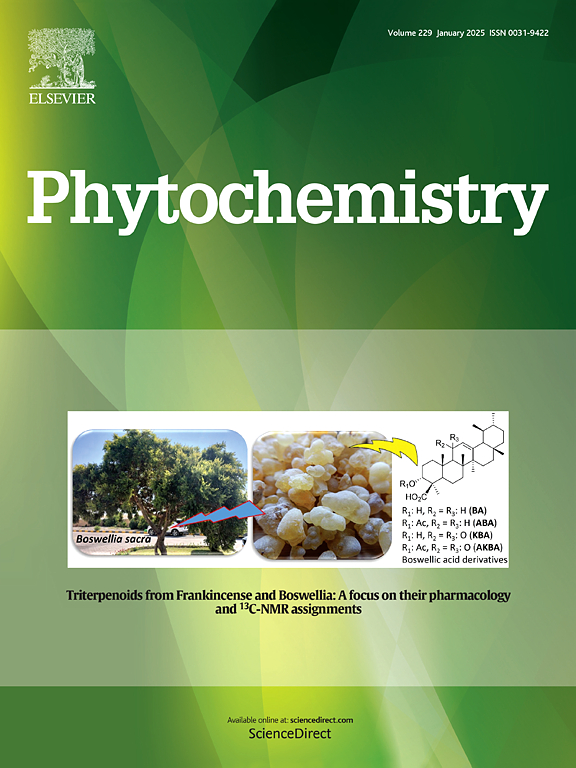Chromosome-level genome of Nardostachys jatamansi and comparative genomics analysis reveals its sesquiterpenoid biosynthesis
IF 3.4
2区 生物学
Q2 BIOCHEMISTRY & MOLECULAR BIOLOGY
引用次数: 0
Abstract
Nardostachys jatamansi (D. Don) DC., an aromatic and medicinal herb belonging to the Nardostachys genus within the Caprifoliaceae family, is globally well-known for its attractive perfume and health-promoting properties. However, genomic information specific to N. jatamansi remains largely unexplored. In this study, the first de novo assembly of the N. jatamansi genome was presented which spans approximately 2.88 Gb with the contig N50 of 9.92 Mb and scaffold N50 of 40.09 Mb. Using Hi-C sequencing data, we successfully anchored 98.53 % of the assembled sequences into 78 pseudochromosomes (6n = 13), a result corroborated by chromosome (cytogenetic) analysis. The genome comprises 92.33 % repeat sequences, including 73.82 % TEs and 18.51 % tandem repeats, as well as a total of 174,054 protein-coding genes, of which 93.62 % have been functionally annotated in databases such as NR, GO, KEGG, Interpro, and others. In addition, our analysis identified 4144 tRNAs, 7537 rRNAs, 707 miRNAs, and 3400 snRNAs within the genome. Comparative genomics revealed that N. jatamansi exhibited high genetic redundancy. Phylogenetic analysis supports the current knowledge that the new APG IV classification system places N. jatamansi within the Caprifoliaceae family. Genes from the most expanded gene families, especially the TPS gene cluster at the end of chromosome 3A, are likely involved in the biosynthesis of sesquiterpenoids in N. jatamansi. Hopefully, our work would provide a valuable basis for revealing natural product-related biosynthetic pathways in N. jatamansi and advancing evolutionary studies within the Caprifoliaceae family.

贾塔马南(Nardostachys jatamansi)染色体水平基因组分析和比较基因组分析揭示了其倍半萜类生物合成
Nardostachys jatamansi (D. Don) DC。是一种芳香和药用草本植物,属于辣椒科的Nardostachys属,以其迷人的香味和促进健康的特性而闻名于世。然而,贾塔曼西n特有的基因组信息在很大程度上仍未被探索。在本研究中,我们首次构建了贾塔马西尼基因组的从头组装,该基因组全长约2.88 Gb, contig N50为9.92 Mb, scaffold N50为40.09 Mb。利用Hi-C测序数据,我们成功地将98.53%的组装序列锚定在78条假染色体上(6n = 13),染色体(细胞遗传学)分析证实了这一结果。基因组包含92.33%的重复序列,其中te序列占73.82%,串联重复序列占18.51%,共有174054个蛋白质编码基因,其中93.62%已在NR、GO、KEGG、Interpro等数据库中进行了功能注释。此外,我们的分析在基因组中鉴定了4144个trna, 7537个rnas, 707个mirna和3400个snrna。比较基因组学研究表明,贾塔曼氏白蚁具有较高的遗传冗余性。系统发育分析支持目前的知识,即新的APG IV分类系统将N. jatamansi置于辣椒科。来自扩展最多的基因家族的基因,特别是位于3A染色体末端的TPS基因簇,可能参与了贾塔马西尼倍半萜类化合物的生物合成。希望我们的工作能够为揭示jatamansi天然产物相关的生物合成途径和推进Caprifoliaceae家族的进化研究提供有价值的基础。
本文章由计算机程序翻译,如有差异,请以英文原文为准。
求助全文
约1分钟内获得全文
求助全文
来源期刊

Phytochemistry
生物-植物科学
CiteScore
6.40
自引率
7.90%
发文量
443
审稿时长
39 days
期刊介绍:
Phytochemistry is a leading international journal publishing studies of plant chemistry, biochemistry, molecular biology and genetics, structure and bioactivities of phytochemicals, including ''-omics'' and bioinformatics/computational biology approaches. Phytochemistry is a primary source for papers dealing with phytochemicals, especially reports concerning their biosynthesis, regulation, and biological properties both in planta and as bioactive principles. Articles are published online as soon as possible as Articles-in-Press and in 12 volumes per year. Occasional topic-focussed special issues are published composed of papers from invited authors.
 求助内容:
求助内容: 应助结果提醒方式:
应助结果提醒方式:


